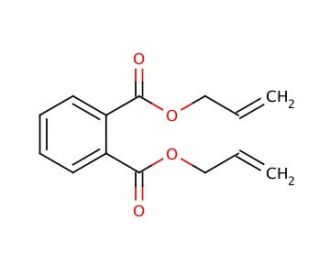

Molecular structure of Diallyl phthalate, CAS Number: 131-17-9
Diallyl phthalate (CAS 131-17-9)
CAS Number:
131-17-9
Molecular Weight:
246.26
Molecular Formula:
C14H14O4
Supplemental Information:
This is classified as a Dangerous Good for transport and may be subject to additional shipping charges.
For Research Use Only. Not Intended for Diagnostic or Therapeutic Use.
* Refer to Certificate of Analysis for lot specific data.
QUICK LINKS
Ordering Information
Description
Technical Information
Safety Information
SDS & Certificate of Analysis
Diallyl phthalate is a blend of isomers that readily attaches to the androgen receptor. This compound maintains its stability even when combined with phosphates, alcohols, and various other organic substances. In animal studies, it has demonstrated carcinogenic tendencies. While the exact physiological impact of this compound remains somewhat elusive, it has exhibited the ability to hinder liver lesions in rats. Moreover, diallyl phthalate has been observed to engage with water vapor and reactive oxygen species like hydroxyl radicals.
Diallyl phthalate (CAS 131-17-9) References
- NTP Carcinogenesis Bioassay of Diallyl Phthalate (CAS No. 131-17-9) in B6C3F1 Mice (Gavage Study). | ,. 1983. Natl Toxicol Program Tech Rep Ser. 242: 1-96. PMID: 12750751
- Preliminary study of responses in mussel (Mytilus edilus) exposed to bisphenol A, diallyl phthalate and tetrabromodiphenyl ether. | Aarab, N., et al. 2006. Aquat Toxicol. 78 Suppl 1: S86-92. PMID: 16580744
- Induction of micronuclei and other nuclear abnormalities in mussels exposed to bisphenol A, diallyl phthalate and tetrabromodiphenyl ether-47. | Barsiene, J., et al. 2006. Aquat Toxicol. 78 Suppl 1: S105-8. PMID: 16616789
- Evaluation of the developmental toxicity of diallyl phthalate administered orally to rats. | Saillenfait, AM., et al. 2008. Food Chem Toxicol. 46: 2150-6. PMID: 18375032
- Multixenobiotic resistance, acetyl-choline esterase activity and total oxyradical scavenging capacity of the Arctic spider crab, Hyasaraneus, following exposure to bisphenol A, tetra bromo diphenyl ether and diallyl phthalate. | Minier, C., et al. 2008. Mar Pollut Bull. 56: 1410-5. PMID: 18599090
- A proteomics based approach to assessing the toxicity of bisphenol A and diallyl phthalate to the abalone (Haliotis diversicolor supertexta). | Zhou, J., et al. 2010. Chemosphere. 79: 595-604. PMID: 20189630
- Determination of phthalate diesters in foods. | Bradley, EL., et al. 2013. Food Addit Contam Part A Chem Anal Control Expo Risk Assess. 30: 722-34. PMID: 23614781
- Magnetic nanoporous carbon as an adsorbent for the extraction of phthalate esters in environmental water and aloe juice samples. | Liu, L., et al. 2015. J Sep Sci. 38: 1411-8. PMID: 25677269
- Study of moving bed biofilm reactor in diethyl phthalate and diallyl phthalate removal from synthetic wastewater. | Ahmadi, E., et al. 2015. Bioresour Technol. 183: 129-35. PMID: 25727760
- Simultaneous determination of 22 phthalate esters in polystyrene food-contact materials by ultra-performance convergence chromatography with tandem mass spectrometry. | Fan, YL., et al. 2018. J Sep Sci. 41: 2993-3002. PMID: 29809316
- Fate of four phthalate esters with presence of Karenia brevis: Uptake and biodegradation. | Sun, C., et al. 2019. Aquat Toxicol. 206: 81-90. PMID: 30468977
- Determination of phthalate esters in bottled beverages by direct immersion solid-phase microextraction with a porous boron nitride coated fiber followed by gas chromatography-mass spectrometry. | Zang, X., et al. 2022. J Sep Sci. 45: 2987-2995. PMID: 35642725
- Evaluating different web applications to assess the toxicity of plasticizers. | Arulanandam, CD., et al. 2022. Sci Rep. 12: 19684. PMID: 36385271
- Examination of the differential hepatotoxicity of diallyl phthalate in rats and mice. | Eigenberg, DA., et al. 1986. Toxicol Appl Pharmacol. 86: 12-21. PMID: 3764931
Ordering Information
| Product Name | Catalog # | UNIT | Price | Qty | FAVORITES | |
Diallyl phthalate, 250 ml | sc-239674 | 250 ml | $36.00 |
